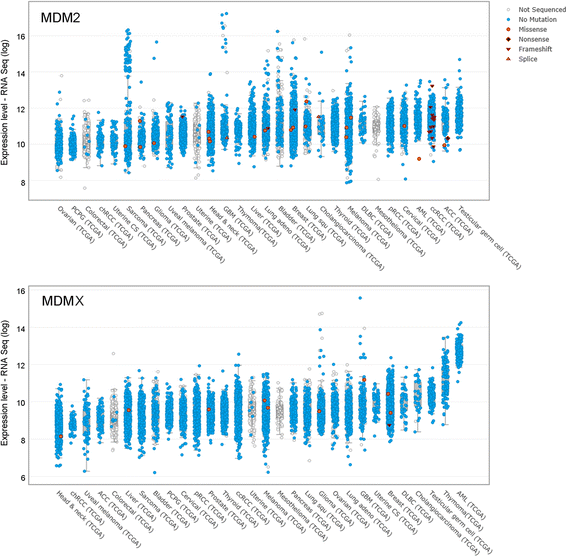MDM2/X inhibitors under clinical evaluation: perspectives for the management of hematological malignancies and pediatric cancer
- PMID: 28673313
- PMCID: PMC5496368
- DOI: 10.1186/s13045-017-0500-5
MDM2/X inhibitors under clinical evaluation: perspectives for the management of hematological malignancies and pediatric cancer
Abstract
The two murine double minute (MDM) family members MDM2 and MDMX are at the center of an intense clinical assessment as molecular target for the management of cancer. Indeed, the two proteins act as regulators of P53, a well-known key controller of the cell cycle regulation and cell proliferation that, when altered, plays a direct role on cancer development and progression. Several evidence demonstrated that functional aberrations of P53 in tumors are in most cases the consequence of alterations on the MDM2 and MDMX regulatory proteins, in particular in patients with hematological malignancies where TP53 shows a relatively low frequency of mutation while MDM2 and MDMX are frequently found amplified/overexpressed. The pharmacological targeting of these two P53-regulators in order to restore or increase P53 expression and activity represents therefore a strategy for cancer therapy. From the discovery of the Nutlins in 2004, several compounds have been developed and reported with the ability of targeting the P53-MDM2/X axis by inhibiting MDM2 and/or MDMX. From natural compounds up to small molecules and stapled peptides, these MDM2/X pharmacological inhibitors have been extensively studied, revealing different biological features and different rate of efficacy when tested in in vitro and in vivo experimental tumor models. The data/evidence coming from the preclinical experimentation have allowed the identification of the most promising molecules and the setting of clinical studies for their evaluation as monotherapy or in therapeutic combination with conventional chemotherapy or with innovative therapeutic protocols in different tumor settings. Preliminary results have been recently published reporting data about safety, tolerability, potential side effects, and efficacy of such therapeutic approaches. In this light, the aim of this review is to give an updated overview about the state of the art of the clinical evaluation of MDM2/X inhibitor compounds with a special attention to hematological malignancies and to the potential for the management of pediatric cancers.
Keywords: Clinical studies; Leukemia; MDM2; MDMX; Pediatric tumors; Pharmacological inhibitor.
Conflict of interest statement
Ethics approval and consent to participate
Not applicable.
Consent for publication
Not applicable.
Competing interests
The authors declare that they have no competing interests.
Publisher’s Note
Springer Nature remains neutral with regard to jurisdictional claims in published maps and institutional affiliations.
Figures


Similar articles
-
Medicinal Chemistry Strategies to Disrupt the p53-MDM2/MDMX Interaction.Med Res Rev. 2016 Sep;36(5):789-844. doi: 10.1002/med.21393. Epub 2016 Jun 15. Med Res Rev. 2016. PMID: 27302609 Review.
-
DIMP53-1: a novel small-molecule dual inhibitor of p53-MDM2/X interactions with multifunctional p53-dependent anticancer properties.Mol Oncol. 2017 Jun;11(6):612-627. doi: 10.1002/1878-0261.12051. Epub 2017 May 2. Mol Oncol. 2017. PMID: 28296148 Free PMC article.
-
Small-molecule MDM2-p53 inhibitors: recent advances.Future Med Chem. 2015;7(5):631-45. doi: 10.4155/fmc.15.13. Future Med Chem. 2015. PMID: 25921402 Review.
-
An Update on MDMX and Dual MDM2/X Inhibitors.Curr Top Med Chem. 2018;18(8):647-660. doi: 10.2174/1568026618666180604080119. Curr Top Med Chem. 2018. PMID: 29866007 Review.
-
Induction of p53 expression and apoptosis by a recombinant dual-target MDM2/MDMX inhibitory protein in wild-type p53 breast cancer cells.Int J Oncol. 2013 Dec;43(6):1935-42. doi: 10.3892/ijo.2013.2138. Epub 2013 Oct 14. Int J Oncol. 2013. PMID: 24126697
Cited by
-
Therapeutic wavelengths of ultraviolet B radiation activate apoptotic, circadian rhythm, redox signalling and key canonical pathways in psoriatic epidermis.Redox Biol. 2021 May;41:101924. doi: 10.1016/j.redox.2021.101924. Epub 2021 Mar 10. Redox Biol. 2021. PMID: 33812333 Free PMC article.
-
Red-light modulated ortho-chloro azobenzene photoswitch for peptide stapling via aromatic substitution.RSC Chem Biol. 2023 Oct 19;5(1):49-54. doi: 10.1039/d3cb00176h. eCollection 2024 Jan 3. RSC Chem Biol. 2023. PMID: 38179193 Free PMC article.
-
Prolonged Idasanutlin (RG7388) Treatment Leads to the Generation of p53-Mutated Cells.Cancers (Basel). 2018 Oct 24;10(11):396. doi: 10.3390/cancers10110396. Cancers (Basel). 2018. PMID: 30352966 Free PMC article.
-
Targeting centrosome amplification, an Achilles' heel of cancer.Biochem Soc Trans. 2019 Oct 31;47(5):1209-1222. doi: 10.1042/BST20190034. Biochem Soc Trans. 2019. PMID: 31506331 Free PMC article. Review.
-
Advancements in Oncoproteomics Technologies: Treading toward Translation into Clinical Practice.Proteomes. 2023 Jan 10;11(1):2. doi: 10.3390/proteomes11010002. Proteomes. 2023. PMID: 36648960 Free PMC article. Review.
References
Publication types
MeSH terms
Substances
LinkOut - more resources
Full Text Sources
Other Literature Sources
Research Materials
Miscellaneous

